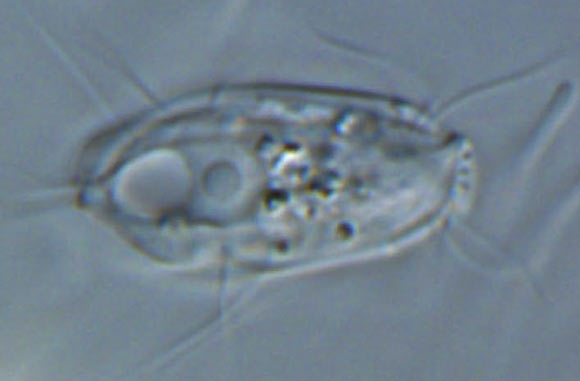A team of researchers from Dalhousie University, Canada, has identified two previously undescribed species of hemimastigotes — members of the extremely rare protist group Hemimastigophora. Through phylogenetic analysis, they found that hemimastigotes represent a previously unrecognized supergroup of eukaryotes. The findings are published in the journal Nature.
“This discovery literally redraws our branch of the Tree of Life at one of its deepest points,” said Dalhousie University’s Professor Alastair Simpson, lead author of the study.
“It opens a new door to understanding the evolution of complex cells — and their ancient origins — back well before animals and plants emerged on Earth.”
First observed in the 19th century, hemimastigotes are free-living eukaryotic protists with two rows of flagella and a unique cell architecture.
“Eukaryotic means the species have complex cells like humans and protist means the species are not animals, plants or fungi,” Professor Simpson and co-authors said.
“Like most protists, they are unicellular. Their flagella are long hair-like structures that allow these organisms to move, and also help them to capture other microbes, which they consume as prey.”

Hemimastix kukwesjijk: general view of cell. Scale bar – 5 μm. Image credit: Lax et al, doi: 10.1038/s41586-018-0708-8.
The team isolated to two new species of hemimastigotes — Hemimastix kukwesjijk and a yet-to-be-named species of the genus Spironema — from a soil sample collected from a region near Halifax, Nova Scotia, Canada.
“It was clear from our analyses that hemimastigotes didn’t belong to any known kingdom-level group, or even to a known ‘super-group’ of several kingdoms together, like the one that includes both animals and fungi,” Professor Simpson said.
“This one little collection of organisms is a whole new group at that level, all on its own. It’s a branch of the Tree of Life that has been separate for a very long time, perhaps more than a billion years, and we had no information on it whatsoever.”
The team’s results are vital for evolutionary biologists striving to piece together how the complex cells of animals, plants, fungi, algae and protozoa have evolved over the last 1-2 billion years.
Further, ecologists around the world studying the hugely important roles of microbes on the planet will now be able to identify hemimastigotes in their genetic datasets; this biodiversity would have passed as unidentified until now.
“Researchers that study the microbial ecology of the ocean, lakes and soils will now be able to detect hemimastigotes in genetic samples pulled from these environments, giving a better understanding of what is actually there, and, potentially, how different microbes are interacting,” Professor Simpson said.
“That such a distinct form of life could be hiding literally under our feet is a sharp reminder about how little we still know about the diversity of life on Earth.”
_____
Gordon Lax et al. Hemimastigophora is a novel supra-kingdom-level lineage of eukaryotes. Nature, published online November 14, 2018; doi: 10.1038/s41586-018-0708-8








